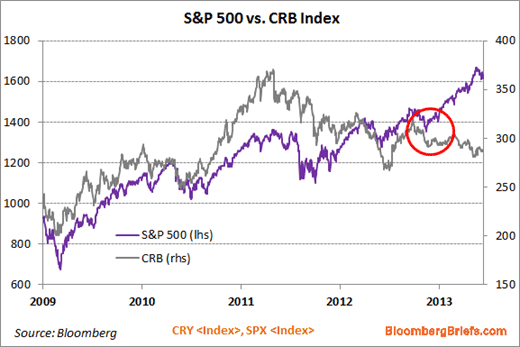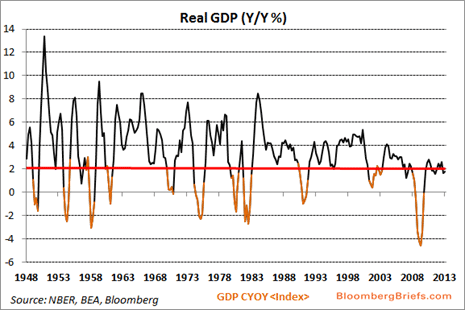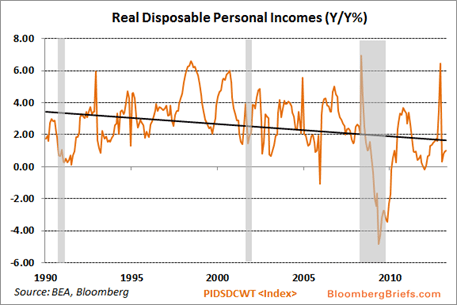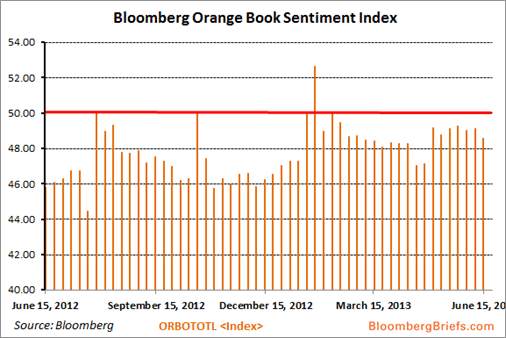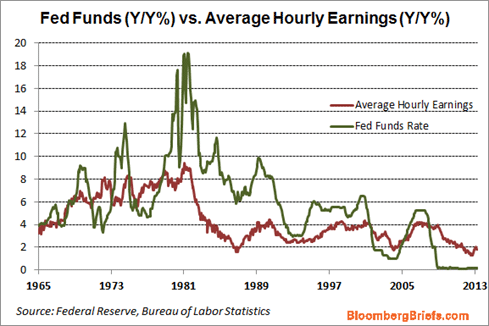As long-time readers know, I have a very eclectic group of friends and associates. Colorful, opinionated, generally both fun and funny, they make for interesting times and discussions wherever I go. Next week I will be in the midst of some unabashed bulls, but today I offer up for your reading pleasure a note from a friend who is on the Dark Side of the fence, though he is hardly what you could call a conventional bear. He is Rich Yamarone, Chief Economist for Bloomberg.
Lately, Rich has become known in the trade as Lord Vader for his always enthusiastic but distinctly gloomy views. You are about to be treated to a missive he writes from the Dark Side, where he is spending the summer, finding many things to worry about. He backs up his concerns with a solid list of facts and data, as well as some of the findings from the Orange Book that he writes each month. The Orange Book is a summation of the economic notes from Rich’s conference calls with the CEOs and CFOs of the largest businesses in the S&P 500. It has become de rigeur reading for those looking for signals from the business community. And what those CEOs tell us is that the economy is soft – which, given that GDP growth is likely to be less than 2% for the year, is confirmation of what we’re hearing from other directions. Herein we learn that things might get bumpy on the ride ahead, but at least we are entertained by Mr. Yamarone even as we are forewarned.
Rich is part of dynamic group of economists who contribute to the Bloomberg Brief: Economics newsletter. Rich, along with my friend Tom Keene and five others, distills the day’s must-know information to about ten pages, every day. And Rich’s Orange Book is part of the deal. Check it out here.
“There is no dark side of the moon really. Matter of fact, it’s all dark.”
Pink Floyd
A recent gut feeling about a global unraveling has forced the Prince of Darkness to issue the following statement regarding the economic climate (as well as provide an open invite to the annual Dark Side summer soiree):
Emerging markets are in turmoil, Europe is spiraling deeper into recession and finance ministers in the region are scrambling to fix the seemingly never ending banking crisis. Turkey is the new hotbed of civil unrest, and central banks and sovereign nations are providing extreme monetary policy accommodation and engaging in currency wars to maintain some sense of stabilization. The World Bank reduced its global economic forecast to 2.2 percent in 2013 – lower than the 2.3 percent performance in 2012.
It was just a matter of time before the conditions started to break down. If you see a 500 lb. man eating a donut and smoking a cigarette, you needn’t be a genius to know the situation isn’t going to end well. Similarly, blistering gains in the equity indexes to record highs amid a sluggish economic performance are simply unsustainable. Look at the bifurcation between the CRB index and the S&P 500; that solid relationship between the market and economy broke down in December of last year, and it now looks as if the S&P will rejoin the commodity benchmark in its tailspin.
GDP advanced by a seasonally adjusted annual rate of 2.4 percent in the first quarter, resulting in a 1.8 percent increase over the previous year – which is usually a recession indicator. For now it’s likely that the economy continues to plod along at this subdued level until one of the many obstacles send it south.
We recently saw of a number of possible signals of a downturn.
The ISM’s PMI fell to 49 in May from 50.7 in April, the first sub-50 reading in the barometer since November (49.9) and the lowest level since Jun 2009 (45.8) when the U.S. economy was emerging from depression. Along the same lines, the key subcomponents of New Orders and Production fell to 48.8 and 48.6 respectively – indicating a contraction in business conditions. This slump doesn’t appear to be solely an American condition.
The difference between the New Orders Index (a proxy for future demand) and the level of existing inventories (expectations by businesses of future demand) was -0.2 in May. Historically a negative reading has been a recession indicator. This isn’t foolproof – there have been several negative postings with a downturn surfacing – but there have been six negative readings since the end of the 2007-2009 depression, which supports a somewhat tepid situation.
The other ISM indicator is the Price Index, which slipped below 50 to 49.5 in May. Below-50 readings are always experienced during recessions. The inability of businesses to raise prices in a challenging economic environment, in combination with a sub-50 reading in the headline PMI and a negative New Orders less Inventories index suggests a notable curtailment in economic growth.
Industrial production has peaked (8.5 percent) in mid-2010 to 1.95 percent today (another indicator that has fallen below that magical 2.0 percent recession level), and manufacturers are slashing jobs again. The regional Fed manufacturing indices are all lingering in crummy territory – at best. Electricity output has fallen in each of the last five weeks (on a year-over-year basis), and shipments of nondefense capital goods excluding aircraft plunged 1.5 percent in April – a messy beginning of the second quarter.
The average length of the last ten expansions is 60.5 months, and we are currently 47 months into the most recent recovery. It isn’t inconceivable that the economy contracts at this point, especially since it has been operating at a pace that has historically suggested recession.
If the global equity market sell-off is not a “Sell in May” event, but rather the beginning of the great unwinding then the economy, already skating on thin ice, is even more susceptible to a downturn.
There is something to consider with respect to the sluggish second quarter start: data revisions have an incredible ability to change the economic landscape and the determination of business cycle strengths and turning points. In 2008, the fourth quarter GDP was initial reported to have declined by 3.8 percent…nine revisions later the actual level stands at -8.9 percent. [Hat tip to my friends at Chilton Capital for bringing it to my attention.]
On July 31, the Bureau of Economic Analysis will revise the National Income Product Accounts (including the GDP report). What happens – pure speculation, but not entirely outrageous – if the final quarter 2012 GDP increase is downwardly revised from its current 0.4 gain to a 0.5 percent decline. And the first quarter 2013 increase of 2.4 is shaved a few basis points to a 1.8 percent increase, and the current quarter comes in negative? Will the chatter pick up about recession? Will a recession be declared? Will those folks at the ECRI be heralded as heroes? Will the Street flock to the Dark Side, and will everyone will want in on our glorious Dark Side picnic. Do we have enough chairs? Stay tuned, its less than two months away…
According to (82) economists polled by Bloomberg, U.S. GDP is expected to increase 1.9% in 2013, following a 2.2% gain in 2012. This is extremely weak by historical standards, and with the exception of one event, has resulted in recession every time since 1948.
This said, we are anticipating the addition of several Street economists to come over and join us here on the Dark Side as well as the annual picnic – we are fully prepared as we asked Beelzebub’s Catering and Party Tent Rentals to provide us with a few hundred extra chairs and tables. (Thanks guys.)
This year’s party might not be as exciting or entertaining as in previous confabs. Just as Fed Chairman Ben Bernanke will not be attending the annual central bank conference in Jackson Hole, Wyoming, we are afraid that a long-time Dark Side headliner (and a dear friend) Dave Rosenberg of Gluskin-Sheff, might not be partying with our Doom and Gloom set. This is a mighty blow – you’ll remember the 2004 and 2005 soirees when Mr. Rosenberg was undoubtedly the life of the Dark Side parties, forewarning all that would listen of the pending housing crisis and subsequent economic doom.
To date, the labor market recovery has been unimpressive. The number of Americans on nonfarm payrolls totaled 135 million in April, the same level as in late 2005. On this basis one can claim the U.S. has “turned Japanese” with a near lost decade of job creation. We should expect results that are similarly poor as in Japan in coming decades: we use the same policy prescription for the same ailment, why wouldn’t we have the same result? If you wrap avocado, cucumber, and rice in Nori with sesame seeds, it’s a California roll. Why would you think it’s something else? [For the record, there is no sushi in the Dark Side.]
It looks like 96,300 of the 175,000 new nonfarm jobs created last month were in very low wage industries (retail, 27,000), temporary, (25,600), leisure and hospitality (43,000). The industries with the two lowest hourly wages are leisure and hospitality ($11.76) and retail ($13.92). It isn’t clear how the world’s largest economy gets back on its feet with so many receiving such low incomes.
In the Dark Side wages don’t matter, everything here is free – it’s not that dark! The single greatest hurdle for the recognized U.S. economy however, is flat-to-declining wages. To some this may sound a tad like a broken record [Apparently vinyl records are more popular than cds right now but the only thing that matters to the economic recovery is incomes.
Real disposable personal incomes – the amount that consumers have to spend once adjusted for inflation and taxes – increased 0.1 percent in April, a mere 1.0 percent higher than year ago levels. Similarly, the amount of spending that Americans facilitated with that lowly income inched up 0.1 percent, or 2.1 percent from April 2012. Real disposable personal incomes had a history of advancing at 3.75 percent, which would boost spending by a similarly robust pace. As long as income growth is staid as it is, the economy will continue to spin its wheels in a sideways movement, and subsequently keep a lid on job creation.
Grab some food stamps…they don’t cost nothing. Some things don’t need to be examined to know what kind of an effect they will have on consumer psyches, spending habits, and ultimately aggregate demand. According to the USDA, there are more than 47 million Americans on the Supplemental Nutrition Assistance Program, more commonly known as food stamps. Since the end of the depression in June 2009, food stamp assistance has accelerated by 30.8 percent, dwarfing job creation of 3.8 percent during the same period. This said, it should come as no surprise grocery and health and wellness in aggregate make up about 66 percent of Wal-Mart’s revenues. More stores are adjusting space for the inclusion of groceries.
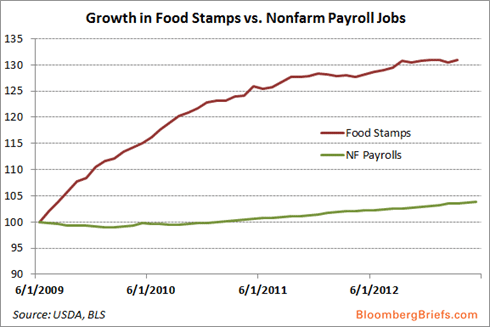
Anecdotes from the Bloomberg Orange Book – admittedly a far too bright colour for those residing here in the place of torment – point to a number of headwinds.
The Bloomberg Orange Book Sentiment Index has been below 50 (a reading of contraction) for eighteen consecutive weeks. Comments continue to paint a picture of souring business conditions.
Consumer companies complain:
Church & Dwight: “I have been a long-term pessimist about the business environment. The latest forecast of weak GDP growth, continuing high unemployment and weak same-store sales growth by our major retailers provides little hope for near-term improvement in the U.S. economy.” “2013 is shaping up to be another very challenging year due to the weak consumer demand.”
Denny’s: “We faced significant headwinds in this quarter, as we lapped our strongest quarter of last year. And our customers felt the impact of higher payroll taxes, gas prices and delayed income tax refunds. As a result, we ended up with our first quarter of negative system-wide same-store sales in almost two years.”
Shoe Carnival: “The government’s delay to act on tax policy and their subsequent decision to raise payroll tax withholding rates had an immediate impact on our consumer. The decision the IRS made to delay accepting tax returns until January 30 also had an immediate and calculable impact on our sales results for the last 10 days of the quarter.”
Express Inc.: “At the same time, traffic is down noticeably compared to last year. Consumers appeared cautious due to the macroeconomic environment and uncertainty around budget cuts and also the impact of higher payroll taxes.”
Kona Grill: “During the quarter, the restaurant industry in general experienced a pullback in consumer spending due to the payroll tax increase, delays in income tax reform, and spiking gas prices, which impacted guest traffic and we were no exception.”
The catatonic state of affairs in Washington, DC is really upending many companies – kind of shocking that in the aftermath of depression, fiscal policy is so incredibly restrictive. Sequestration is on the minds of many companies, and it is not limited to the aerospace and defense industry:
Kelly Services: “We expect the current pace of growth will continue as the U.S. labor market remains fragile and unpredictable with no clear signs of momentum. Add to that there is ongoing uncertainty about the effects of sequestration and rising anxieties surrounding the impending Affordable Care Act, which is one of the most significant issues facing our industry today.”
Armstrong Worldwide: “On the commercial front, in the U.S., we anticipate a continuation of flat to slightly down commercial volumes, with ongoing weakness in education and, to a lesser extent, healthcare.”
Hertz Global Holdings: “In April, we experienced some softness in both the car and equipment rental businesses in the U.S. due to the holiday shift and the initial impact of the sequester. Volumes in our government businesses were down double digits this month, and our commercial accounts with exposure to government customers also cut back on travel.”
UPS: “Although the U.S. economy is poised for growth, it is being restrained somewhat by the tax increases and sequestration implemented during the first quarter. This will be a drag on 2013 GDP expansion with current expectations for about 2% growth.”
Lockheed Martin: “I think as we looked forward for the next three quarters, we do expect to see some pressures from sequestration. They’ve not played out at this point, but we do expect them to happen in the next three quarters.”
Internationally, Bloomberg Orange Book anecdotes have highlighted great concern:
Sealed Air: “As a Frenchman, I can tell you I’m very concerned about the French economy. It’s been moving towards Spain and Italy instead of moving towards Germany. And it shows in our equipment business, equipment and tools business.”
Air Products & Chemicals: “In North America we experienced modest growth; Europe sunk deeper into recession, with Southern Europe remaining particularly weak while the Northern Continent and Central Europe worsened; and in Asia there was a slower-than-expected ramp-up after the Lunar New Year holiday.”
Cooper Tire & Rubber: “China’s economy continues to grow at a slower pace than recent historical rates and Europe’s economy remains stalled. Combined, all of these challenges resulted in Cooper’s shipping volumes being 8% lower than the prior-year first quarter…”
Avis Budget: “Interestingly the markets that were weak last year Italy and Spain seemed to have stabilized thus far in 2013, while France and the UK continued to show some signs of weakness. Germany, which was the lone moderately strong performer last year, has softened this year in line with its softening economy.”
McDonald’s: “Japan’s performance for the quarter was negatively impacted by the difficult economy, a declining IEO industry, and ongoing consumer sensitivity to prices and promotions. Japan continues to evaluate and adjust its plans to complement existing value initiatives with new product news that drives long-term profitable sales and guest counts.”
Central banks all over the world are singing the song of unconventional monetary policy. Now we are all lead to believe that the Bank of Japan’s most recent announcement to adopt a $1.4 trillion quantitative easing program will be the magical elixir to its multi-decade ailments. This seems a little doubtful; as Tanya Tucker sang, “It’s a little too late to do the right thing now.”
The incomes and wage channel hold the answers to countless economic issues. Other than the obvious influences on confidence, spending, corporate profits, and hiring, there is the impact on policy prescriptions. As long as there is disinflation or deflation in average hourly earnings, the Fed should be expected to its foot on the accelerator, and refrain from tapering in the near term.
Many pundits are pointing to geopolitical uprisings as cause for concern to the U.S. economic recovery efforts. Economically speaking, the American consumer – the ultimate driver of aggregate demand – cares little about the goings on overseas. You’ll never overhear Mom pushing junior in a Wal-Mart or Target saying, “We’re not buying any toys today, there’s civil unrest in Turkey.” Investors should expect any meaningful impact from the strife in Cyprus, Syria, or any other nation that is not economically influential.
Our friend Lucifer of Lucifer’s Econometric Forecasting & Astrology informed us that this year might not be something to get excited over. Earlier this year, the Chinese zodiac welcomed the Year of the Snake. Previous “snake years” haven’t been kind to the U.S. economy; of the last ten (1893, 1905, 1917, 1929, 1941, 1953, 1965, 1977, 1989, and 2001), the U.S economy had experienced two recessions (1953, 2001) and two depressions (1893, 1929). Other years experienced similarly profound bouts of calamity, i.e.; in 1917 the U.S. entered WW-I, and in 1941 entered WW-II. Snakes are seldom overlooked and have a tendency to strike sharply when ignored.
So while you are making your plans for this summer and the early fall, remember: here in the Dark Side there’s an open invite for the excellent assortment of dark beers for your consumption – they are warm. After all, this is the Dark Side. There’s a wonderful dark chocolate cake for dessert, and Marilyn Manson is scheduled to be the warm-up band for Alice Cooper on Laborless Day, who will be performing at 5:00 pm in the Satan’s Den. Thanks again for considering, your table is ready.
Lord Vader
Richard Yamarone is an economist who focuses on monetary and fiscal policy, economic indicators, fixed-income, commodities, and general macroeconomic conditions for Bloomberg Brief: Economics, a daily newsletter that features analysis, data and news on the forces shaping the global economy. Mr. Yamarone and the Bloomberg Brief economics team provide in-depth analysis of macroeconomic data, policy, and trends and how they will impact financial markets.
You can download a sample issue of Bloomberg Brief: Economics here. Subscribers get Rich’s Orange Book as part of the deal.
See Also:
- Financial Calculators
- So Long, US Dollar As World’s Reserve Currency
- Bank Safety: How to Protect Your Cash in Times of Crisis
- Gadgets for Hedging Financial Risks
- Alternatives to Trading in a Shaky Economy
Recommended Books:
- The Little Book of Bull’s Eye Investing By John Mauldin
- Endgame: The End of the Debt Supercycle and How It Changes Everything By John Mauldin
- The Trader’s Guide to Key Economic Indicators by Richard Yamarone
- Just One Thing: Twelve of the World’s Best Investors Reveal the One Strategy You Can’t Overlook
- Probable Outcomes- Secular Stock Market Insights
Like Outside the Box?
Sign up today and get each new issue delivered free to your inbox. It’s your opportunity to get the news John Mauldin thinks matters most to your finances.

